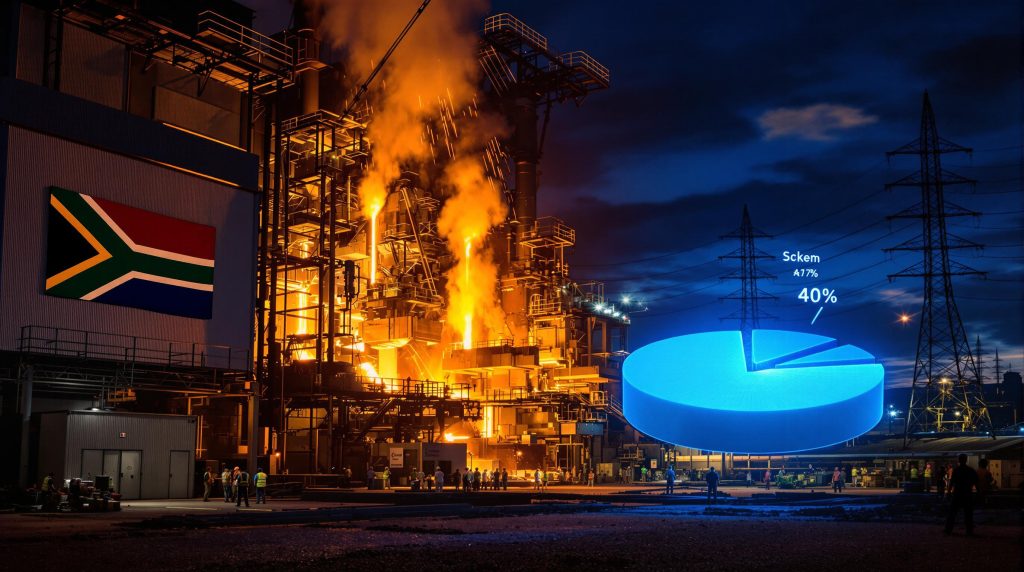Revitalizing Ferromanganese Production: Khwelamet's Meyerton Plant Awaits Eskom Power Rate Decision
The South African ferroalloy industry is on the cusp of a significant revival as Khwelamet prepares to breathe new life into the dormant Meyerton ferromanganese plant. This strategic initiative hinges critically on securing economically viable electricity rates from national power utility Eskom, highlighting the complex interplay between industrial development and energy economics in South Africa's resource-rich economy.
Historical Context of the Meyerton Plant
The Meyerton facility, previously operated as Metalloys, was once a cornerstone of South Africa's ferromanganese production capacity. With four substantial furnaces, the plant played a vital role in converting the country's abundant manganese resources into value-added ferroalloy products for both domestic use and export markets. The facility's dormancy has represented a significant loss to South African mineral beneficiation capabilities and industrial value chain.
According to Vuslat Bayoglu, Managing Director of Menar, "The minute that Eskom gives Khwelamet an economically feasible power price, the refurbishing of two of the four furnaces at the dormant former Metalloys plant in Meyerton will begin and take six to nine months to complete." This statement underscores both the readiness to proceed and the critical nature of electricity pricing to the project's viability.
Current Status and Revival Timeline
Khwelamet's acquisition of the Meyerton facility represents a strategic move to capitalize on South Africa's natural resource advantages while addressing the challenges that led to the plant's closure. The company has established a clear phased approach to revival:
- Initial refurbishment focused on two of the existing four furnaces
- Projected completion timeline of 6-9 months from project commencement
- Subsequent phases to potentially bring additional furnaces online as market conditions permit
- Implementation of modernization efforts to enhance efficiency and environmental performance
This methodical approach reflects an understanding of both market realities and operational complexities involved in revitalizing metallurgical production facilities after extended dormancy periods.
Why is Electricity Pricing Critical for Ferromanganese Production?
Energy Intensity of Ferromanganese Smelting
Ferromanganese production ranks among the most electricity-intensive metallurgical processes in the industrial sector. The smelting process requires sustained high temperatures in electric arc furnaces, typically consuming between 2,300-3,100 kWh per ton of ferromanganese produced. This extraordinary energy requirement means electricity typically constitutes 30-40% of total production costs, making power pricing the single most decisive factor in operational viability.
The process involves:
- Heating manganese ore with carbon and iron in electric arc furnaces at temperatures exceeding 1,600°C
- Continuous operation requirements that demand reliable, uninterrupted power supply
- Precision temperature control that becomes compromised during load shedding or power fluctuations
- Energy consumption that significantly exceeds most other manufacturing processes
South African Electricity Challenges
South Africa's metallurgical sector has faced mounting challenges related to electricity supply and pricing that have eroded its historical competitive advantages:
- Eskom tariff increases averaging 15-20% annually over the past decade, far outpacing inflation
- Intermittent load shedding that disrupts continuous operations and damages equipment
- Reliability issues resulting in production losses and increased maintenance costs
- Competitive disadvantages against producers in regions with lower energy costs, such as Malaysia and parts of China
These challenges have transformed South Africa from a low-cost electricity jurisdiction to one where energy costs represent a significant competitive disadvantage for energy-intensive industries. The push for electrification in mining operations highlights similar energy transitions happening across the global resources sector.
Economic Feasibility Requirements
For the Khwelamet project to advance from planning to implementation, several critical energy-related factors must align:
- Negotiated industrial electricity rates that reflect the volume consumption and economic multiplier effects
- Long-term pricing stability to support investment recovery over multiple years
- Guaranteed supply reliability to prevent costly production disruptions
- Competitive positioning against international producers with established operations
Without these foundational elements, the significant capital investment required for refurbishment cannot be justified in light of global competition and market conditions.
How Does This Compare to Other Mining Cost Management Strategies?
AngloGold Ashanti's Cost Containment Success
In contrast to the challenges faced by ferroalloy producers, gold mining company AngloGold Ashanti has demonstrated remarkable success in cost management under CEO Alberto Calderon's leadership. As reported by Mining Weekly, the company has:
- Maintained cost increases below 2% while industry peers average 15%+ increases
- Implemented strategic operational efficiencies that have created sustainable cost advantages
- Developed innovative approaches to resource management that maximize yield while minimizing input costs
- Established competitive advantages through disciplined cost control methodologies
This performance differential illustrates that even in an inflationary environment, strategic management approaches can significantly mitigate cost pressures in resource-intensive industries.
Industry-Wide Cost Pressures
The mining and metallurgical sectors globally are experiencing unprecedented cost inflation pressures across multiple operational dimensions:
- Rising energy costs affecting all production stages from extraction to processing
- Increased labor expenses driven by skill shortages and wage pressures
- Higher equipment and maintenance costs due to supply chain disruptions
- Increased compliance and regulatory expenses affecting operational freedom
These pressures have forced companies throughout the resource sector to prioritize cost management as a core strategic imperative rather than a peripheral concern. Modern data-driven mining operations have become increasingly important in identifying efficiencies.
Strategic Approaches to Cost Management
Leading operators in mining and metallurgical sectors have implemented various innovative strategies to manage costs effectively:
- Energy efficiency improvements including heat recovery systems, optimized furnace designs, and demand management technologies
- Operational optimization through digitalization, predictive maintenance, and process control enhancements
- Strategic supplier relationships including long-term contracts with price stability mechanisms
- Technological innovation focused on reducing input requirements while maintaining output quality
These approaches demonstrate that while external factors like electricity pricing remain critical, internal operational excellence provides complementary pathways to enhanced competitiveness.
What Are the Broader Implications for South Africa's Metallurgical Industry?
Employment and Economic Impact
The revival of the Meyerton plant represents more than just restored production capacity – it carries significant socioeconomic implications:
- Creation of several hundred direct employment opportunities across operational and technical roles
- Stimulation of thousands of indirect jobs throughout the supply chain and service sectors
- Economic revitalization in the Meyerton region through increased economic activity
- Enhanced foreign exchange earnings through export-oriented production
In a country facing unemployment rates exceeding 30%, these employment benefits extend far beyond the facility's boundaries to impact broader community wellbeing and economic development.
Industrial Development Strategy
South Africa's metallurgical sector represents a critical component of the country's industrial development strategy that leverages natural resource advantages:
- Value addition to locally mined resources, multiplying the economic benefit compared to raw ore exports
- Manufacturing capacity enhancement that strengthens industrial capabilities
- Technology transfer opportunities that build human capital and technical expertise
- Reduced reliance on imported ferroalloys, improving trade balance and economic resilience
The Khwelamet project aligns with national strategic priorities around resource beneficiation and industrial development, making its success relevant to broader policy objectives and industry innovation trends.
Competitiveness in Global Markets
For South African ferroalloy producers to compete effectively in international markets, several factors must align to offset challenges:
- Competitive electricity pricing that recognizes the strategic importance of metallurgical industries
- Reliable power supply that enables consistent production planning and delivery
- Efficient logistics infrastructure including rail capacity and port access
- Supportive regulatory environment that recognizes the unique challenges of energy-intensive industries
Without alignment across these dimensions, even South Africa's substantial natural resource advantages may prove insufficient to maintain international competitiveness.
How Does South Africa's Ferromanganese Industry Compare Globally?
International Market Position
South Africa maintains several structural advantages in the global ferromanganese industry despite current challenges:
- Approximately 80% of the world's known manganese ore reserves, providing unmatched resource security
- Established metallurgical expertise developed over decades of production experience
- Strategic geographic positioning for exports to both European and Asian markets
- Integrated production capabilities from mining through smelting and refining
These foundational strengths provide the basis for a potentially revitalized sector if enabling conditions are established.
Competitive Challenges
Despite natural advantages, South African producers face several competitive challenges:
- Electricity costs 2-3 times higher than competitors in regions like Malaysia, reducing margin potential
- Power supply reliability issues disrupting production cycles and damaging equipment
- Logistics constraints including rail capacity limitations and port congestion affecting delivery reliability
- Regulatory compliance costs and complex administrative requirements increasing operational burden
These challenges have contributed to South Africa's declining global market share in ferromanganese production despite its resource dominance.
Future Growth Potential
With favorable conditions, South Africa's ferromanganese industry could experience substantial growth driven by:
- Increased production capacity utilization at revitalized facilities like Meyerton
- Export market expansion leveraging South Africa's geographic positioning
- Value-added product development targeting premium market segments
- Integration with downstream manufacturing to capture additional value
This growth potential represents a significant opportunity for industrial development and economic diversification if enabling conditions can be established.
What Steps Are Needed to Secure the Industry's Future?
Power Supply Solutions
Addressing electricity challenges requires a multi-faceted approach combining public and private initiatives:
- Negotiated industrial tariffs recognizing the strategic importance of energy-intensive industries
- Power purchase agreements with independent producers to secure supply and pricing
- Self-generation capabilities where technically and economically feasible
- Energy efficiency improvements to reduce consumption intensity per unit of output
Progress on these fronts would significantly enhance the viability of ferromanganese production in South Africa.
Policy and Regulatory Support
Government policy interventions that could support the sector include:
- Industrial electricity pricing frameworks that recognize international competitiveness requirements
- Export promotion initiatives including logistics infrastructure improvements
- Skills development programs targeting metallurgical expertise
- Regulatory streamlining to reduce compliance costs and administrative burdens
These interventions would create an enabling environment for private sector investment and operational success. Effective modern mine planning approaches can further enhance project viability.
Technological Innovation
Advancing technological capabilities offers potential solutions to structural challenges:
- Energy-efficient smelting technologies reducing electricity consumption per ton produced
- Process optimization systems enhancing yield and reducing waste
- Alternative reduction methods decreasing reliance on conventional energy sources
- Waste heat recovery systems capturing and reusing thermal energy
Investment in these technological domains could substantially improve the competitive positioning of South African producers despite external challenges.
FAQs About Ferromanganese Production in South Africa
What is ferromanganese used for?
Ferromanganese is a critical alloy used primarily in steelmaking to improve strength, hardness, and wear resistance. It functions as both a deoxidizer and an alloying element, with approximately 30-35 pounds used per ton of steel produced. This makes it essential for producing high-quality steel products used in:
- Construction (structural beams, reinforcing bar)
- Automotive manufacturing (chassis components, engine parts)
- Infrastructure development (bridges, railways)
- Heavy machinery and equipment manufacturing
The versatility and irreplaceability of manganese in steel production underpins consistent global demand for ferromanganese.
Why is electricity cost so important for ferromanganese production?
The production process requires extremely high temperatures achieved through electric arc furnaces, making electricity the single largest cost component. Specifically:
- Electricity typically represents 30-40% of total production costs
- Production requires 2,300-3,100 kWh per ton of ferromanganese
- Furnaces must operate continuously to maintain efficiency
- Even small changes in electricity rates can shift a facility from profitable to unprofitable
This extraordinary electricity intensity makes power pricing the decisive factor in operational viability and international competitiveness.
How does South Africa's manganese resource position compare globally?
South Africa possesses approximately 80% of the world's known manganese ore reserves, giving it an unmatched natural advantage in ferromanganese production. Key attributes include:
- High-quality deposits with favorable manganese-to-iron ratios
- Extensive proven reserves ensuring multi-decade production potential
- Varying ore grades enabling production of different ferromanganese specifications
- Established mining infrastructure and technical expertise
This resource advantage provides the foundation for a potentially robust ferromanganese industry if enabling conditions are established.
What are the environmental considerations for ferromanganese production?
Modern ferromanganese production facilities implement various environmental controls to mitigate impacts:
- Dust collection and filtration systems capturing particulate emissions
- Water treatment and recycling processes reducing consumption and contamination
- Energy efficiency measures decreasing carbon footprint per ton produced
- Slag management and utilization programs converting waste into construction materials
These environmental management systems represent significant capital investments but are essential for sustainable operations and community acceptance.
How does ferromanganese production contribute to South Africa's economy?
The industry creates significant value through multiple economic channels:
- Direct and indirect employment throughout the value chain
- Foreign exchange earnings through export sales
- Tax revenue generation supporting government services
- Industrial capability development strengthening manufacturing potential
- Support for downstream industries including foundries and steel producers
These contributions extend far beyond the immediate production facilities to impact broader economic development trajectories.
The Road Ahead for South African Ferromanganese
The potential revival of the Meyerton ferromanganese plant under Khwelamet's ownership represents a pivotal moment for South Africa's metallurgical industry. While the challenges are substantial, particularly regarding electricity pricing and reliability, the opportunity to leverage the country's extraordinary manganese resources through value-added production remains compelling.
Success will require alignment between private sector investment, government policy support, and technological innovation. If achieved, the benefits would extend from direct employment to broader industrial development and export earnings, supporting South Africa's economic development objectives.
As Khwelamet awaits Eskom's decision on power rates, the outcome will signal much about South Africa's industrial future and its ability to convert natural resource advantages into sustainable economic development.
Want to Stay Ahead of Major Mineral Discoveries?
Discovery Alert's proprietary Discovery IQ model delivers immediate notifications when significant mineral discoveries are announced on the ASX, giving you the edge in identifying actionable investment opportunities. Explore why historic discoveries can generate exceptional returns by visiting Discovery Alert's dedicated discoveries page.




